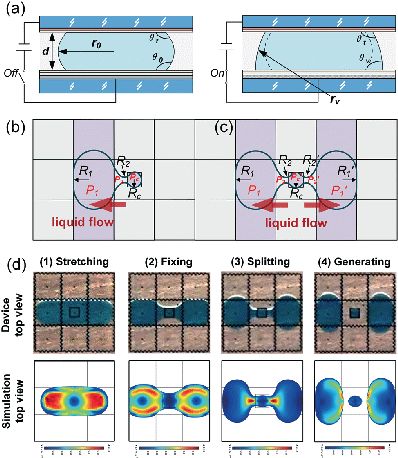Digital microfluidics (Digital microfluidics) is a technology that uses electrical signals on a chip to precisely manipulate the movement of a small amount of liquid through an electrode array, which has been widely used in chemical synthesis, biological analysis, disease diagnosis and other fields.This technology takes the advantage of the design concept of semiconductor technology and consumer electronics to realize automatic rapid point-of-care testing(POCT) on a palm-sized microfluidic chip without the assistance of peripherals. The chip is highly compatible and can be used to quantitatively analyze a variety of proteins and biomolecules.
The principle of this technology is to correspondingly change the hydrophilicity and hydrophobicity of the chip electrode surface via changing the voltage of the chip electrode, resulting in a contact angle difference of the droplet between the adjacent electrode surface, introducing a difference in the surface tension of the droplet in different directions. This tension difference can be used to drive the droplet directional movement, splitting, and merging. Among them, how to efficiently and stably generate micro-droplets is the core and most difficult part of digital microfluidic technology.
In reality, when the ratio of the chip gap to the size of the electrode exceeds a certain threshold, it becomes extremely difficult for the droplets to tear into smaller droplets. Because of this factor, when the chip structure and size are fixed, the minimum volume of droplets that can be generated is limited. If this limitation can be broken to generate smaller droplets, more detection can be processed in a limited chip area, finally resulting in an enhanced detection throughput of the system.
Meanwhile, as the droplet becomes smaller, the flexibility of specific experiments such as on-chip sample dilution and magnetic bead cleaning will be significantly improved, which greatly broadens the application potential of digital microfluidic technology in the POCT field.

Based on the principle that the surface tension can maintain the balance at the position of the geometric center after the droplet is torn symmetrically, ACXEL's method can efficiently tear one big droplet into three tiny droplet, including one with high aspect ratio, without changing the geometric dimensions of the digital microfluidic chip. This droplet tearing method exceeds the geometric limit of dielectric wetting digital microfluidics.
Combining the advantages of "One-to-three" droplet generation method, the team integrated magnetic attraction module, optical detection module, three-axis control module, droplet drive system, etc., and developed a set of fully automatic path compilation, detection data reading , and 3-axis orientation control software. Through continuous testing and optimization of the system, a complete set of fully automated digital microfluidic chemiluminescence immunoassay platform has been successfully constructed.
This highly integrated platform can quickly complete efficient magnetic bead washing. Finally, 5 B-type natriuretic peptide samples can be detected in parallel on one chip at the same time within 10 minutes. theoretical breakthrough, functional design and engineering development. The research results can be applied to the quantitative and rapid detection of B-type natriuretic peptide in human serum, and have certain value in the diagnosis of heart failure, prognostic evaluation, disease monitoring, and treatment guidance.

These results were published, titled "One-to-three" droplet generation in digital microfluidics for parallel chemiluminescence immunoassays, in Lab on a chip which is one of the top academic journals of microfluidics technology. This paper was selected as the inside cover paper, and included in the 2021 popular paper collection. The first author is doctoral student Jin Kai, and the corresponding authors are Prof. Hanbin Ma, Suzhou Institute of Biomedical Engineering Technology(CAS), and Prof. Jinhua Li, Changchun University of Science and Technology.








